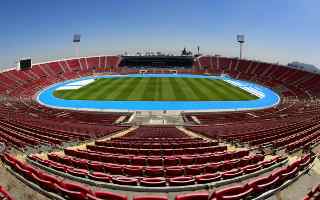Estadio Fiscal de Talca
| Capacity | 16 070 |
|---|---|
| Country | Chile |
| City | Talca |
| Clubs | Club Social de Deportes Rangers |
| Inauguration | 1937 |
| Renovations | 2010-2011, 2017-2019 |
| Cost | CLP 4 billion (2011), CLP 8.3 billion (2019) |
| Contractor | Digua Constructora e Inmobiliaria |
| Address | 251 Avenida Liber Bernardo O'higgings, Talca, Maule, Chile |
Advertisement
Estadio Fiscal – stadium description
Commonly known as “El cementerio de elefantes” (Cemetary of elephants), the stadium in western Talca (central Chile) dates back to 1937 and from the very start has een home to Rangers de Talca. Initially its auditorium was focused around the landfill-based east stand, with the west stand added later, reaching 12,000 capacity at peak. In 1990s, thanks to Chile's partnership with Spain, modern running track was created. But, with passing time, the venue has been deteriorating significantly.
Crucial changes began in 2010-11, when major redevelopment was carried out as part of nationwide stadium programme honouring Chile's bicentennial. New west stand was built from scratch with partial cover and floor space of 3,530 m2. The historical east stand was covered with new steps and seats. While changes boosted the stadium's standard, they've also resulted in capacity decrease from 12,000 to 8,300 due to seat installation. It was already then confirmed that second phase would come at a later date.
The promise was kept by the ministry of public works in 2017. West stand was expanded (both in terms of seating and floor space) and fully covered. East stand received free standing pavilions with sanitary and catering infrastructure for fans. Both ends were erected from scratch and covered – along with the east stand – with 7,700 m2 of PVC membrane.
Along with revised design the north-western side was left with an opening. It serves not just as technical passage for vehicles but also a welcoming gate for fans, many of whom arrive at the stadium from this side.
Like with many stadia in Chile, the project is characterised by disciplined time frame and spending. First phase took only 255 days to deliver, while the second lasted longer around – 470 days. In total reconstruction consumed 12.3 billion pesos (upon reopening some $15.5 million).
Advertisement
Pictures
-

2019 © Espacio Cubierto 
2019 © Espacio Cubierto 
01.2019 © DeUno Comunicaciones / Gobierno Regional del Maule 
01.2019 © DeUno Comunicaciones / Gobierno Regional del Maule 
01.2019 © DeUno Comunicaciones / Gobierno Regional del Maule 
01.2019 © DeUno Comunicaciones / Gobierno Regional del Maule 
01.2019 © DeUno Comunicaciones / Gobierno Regional del Maule 
01.2019 © DeUno Comunicaciones / Gobierno Regional del Maule
Related news
2024
2020
-

Stadium of the Year 2019: The Popular Vote is officially open!
And we're off! For the next five long weeks we'll be accepting your votes and together we'll be selecting the best stadium opened in 2019. The list isn't long but there's so much to choose from!
-

New stadium: Yet one more interesting case from Chile
Chilean stadium projects are really sensible and don't lack creativity at the same time. We've seen many of them already and in this edition of Stadium of the Year we'll have one more, this time from Talca.
-

Stadium of the Year 2019: Your time to nominate!
For over a week everyone around the world is eligible to suggest which stadiums opened in 2019 should be included on the list and compete to become Stadium of the Year 2019. Which will those be?

 StadiumDB
StadiumDB